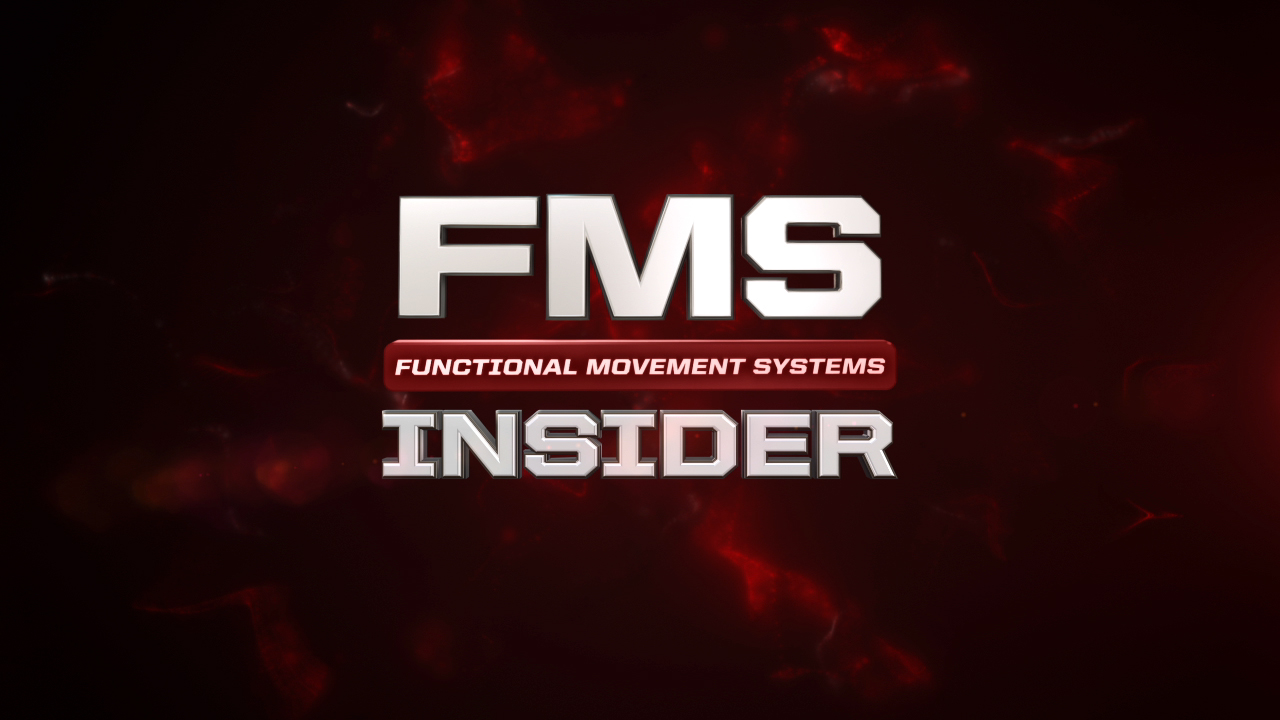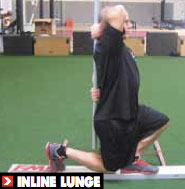Pain In The FMS
Written by Brett Jones FMS

“Define pain?”
Someone attending a course (Healthcare Provide or Fitness professional) will usually ask this question at some point and individuals we screen will ask it as well. It’s not a trick question. But individuals (professional and not) seem to be confused as to what pain is and how to define it. And providing clarity on this question can help provide better answers in using the FMS.
As FMS professionals we know that finding Zero’s (pain) on the FMS is a key aspect and goal of the screen. Identifying painful patterns and areas allows us to make referrals to Healthcare Providers, and to make good programming decisions. When Gray wrote the book Movement, Principle #1 was “Separate painful movement patterns from dysfunctional movement patterns whenever possible to create clarity and perspective.” The question that pain provokes
(ha-ha-ha…movement screening humor…) is: “Are you moving poorly because you are in pain or you in pain because you are moving poorly?” The only way to answer that question is to take the pain out of the equation.
So, what is pain?
From my previous article on “Pain, Dysfunction, and Load”:
“What is pain? “Pain scientists are reasonably agreed that pain is an unpleasant feeling in our body that makes us want to stop and change our behaviour.” Lorimer Moseley
He continues: “Pain depends upon the brain evaluating a massive amount of information, including danger data from the danger detection system, but also cognitive data (for example expectations, previous exposure, cultural and social norms, beliefs – the context is critical [4]) and other sensory data (for example that from vision [5], or that from other sensors in the area).” http://www.bodyinmind.org/what-is-pain/
“Our understanding of pain has progressed tremendously over the last few years and it is a multifactorial experience that we as fitness professionals need to work with Healthcare providers to treat and work with appropriately. What we do know is that pain alters motor control and whenever possible we want to look at movement uncomplicated by pain.”
Motor Control and why looking at movement uncomplicated by pain is important:
Greg Dea’s excellent article “Regional Interdependence And Limiting Factors To Performance” (Part 1) includes some great info on pain and its impact on motor control.
“Pain-attenuated movement patterns can lead to protective movement and fear of movement, resulting in clinically observed impairments such as decreased range of motion, muscle length changes, declines in strength, and ultimately may contribute to the resultant disability.” (Cook, cited in (Cook, 2010), p.117). Each response to pain is dependent on the specifics of a task….
To reiterate, the only way you can’t say this pain isn’t interfering with that is to remove the pain first. While changing painful dorsiflexion to non-painful may not change vertical leap, it will remove a potential trigger to altered motor control up the kinetic chain which will eventually help clarify the fundamental issue.”
“As stated above, pain can change the control of movement higher up the kinetic chain. It can even lead to anxiety about impending pain during an activity (Moseley et al., 2003), reduced perception of ability and reduced performance (Deschamps et al., 2014), at least in acute pain. Such a scenario is the essence of regional interdependence: pain anywhere can affect a movement pattern in the whole kinetic chain.”
And there is research that pain alters performance:
“The presence of pain has been shown to be associated with altered motor control (known as functional instability) compared to control subjects in cutting maneuvers (Son et al., 2017).”
Answering the question
Defining pain in relation to movement screening:
“Pain – a physical feeling that includes (but not limited to) distress, tenderness, burning, aching, pinching, jamming, radiating, sharpness or soreness that is unqualified or unexplained.”
Gray continues with a pain criteria checklist:
- Familiar – occurring on a regular or on a consistent basis
- Produced by common movements – noticed in daily activities and exercises
- Signs of concern or stress – the person notes pain, seems focused on or is distracted or distressed by pain (Movement pg. 84)
This usually leads to being asked what the difference is between pain and discomfort.
Well discomfort in this context can be defined as: “a non-distressing or non-alarming physical feeling that includes awkwardness, uneasiness, mild tightness, or qualified soreness caused by exercise…” This can be unfamiliar and only produced with awkward movements. No sign of concern or stress can be a big factor between pain and discomfort and “discomfort” will usually subside with repeated movements. (Movement, pg. 84)
So, the FMS professional needs to be a good detective watching for signs of stress and concern (facial expressions and breathing are big keys here) and needs to ask questions to understand what the client is saying. Is it a pinching or burning sensation? Have you felt this sensation before? You must be armed with easily answered questions to assist you in understanding the sensation.
Typical interactions during screening:
Was there pain with that movement?
Client: No, it just felt really tight.
Answer – likely discomfort
Was there pain with that movement?
Client: Yes, that really burned.
Have you felt that before?
Client: Yes, going up and down steps.
Answer – likely pain
Was there pain with that movement?
Client: I’m not sure it felt “weird”.
Any pinching, or stabbing sensations?
Client: No.
Did it feel like a stretch?
Client: Yeah, a big stretch.
Answer – likely discomfort
Take the time to dive in and get clarity from the person being screened.
To continue or not to continue…that is the question
Seriously, when is a Shakespeare paraphrasing not appropriate…?
“So, if I find pain I stop the screen?” That is the question.
There are benefits and risks to continuing the screen in the presence of pain from Gray Cook's book, Movement.
Risks:
- The situation causing the pain could be aggravated.
- The person might be fearful or apprehensive.
- The painful episode may alter movement and not give a clear picture of the client’s current functional status.
Benefits:
- A complete screen can provide a thorough representation of movement.
- More than on movement pattern can cause the same pain. (more info for referral)
- A different pain may be discovered if all movement pattern tests are performed.
- A complete screen can serve as a baseline for future reference.
As professionals we must all decide and weigh the risk and benefit of continuing with our experience and comfort in the presence of a painful finding. Pain that is found that becomes persistent (does not go away after provocation) or increases after provocation is certainly a signal to stop and proceed with referral. Outside of that situation, continuing with the screen provides more information either for programming or for the Healthcare Provider to whom you are referring. Finding patterns uncomplicated by pain allows for movement opportunities and having a complete screen allows you to see what changes once the pain is no longer complicating the movement(s).
What to do with discomfort?
We recommend scoring discomfort a Zero like pain but without referral. You will monitor the discomfort following Principle #2 (Protect before you Correct) and recheck the discomfort after each session. Protect (avoid) the discomfort while addressing the next score of One or asymmetry in the corrective algorithm just as you would with pain. If the discomfort remains and does not change then referral is recommended.
Conclusion
Finding clarity is usually the result of asking the right questions and providing information that assists in understanding what is being asked. Pain is a complicated multifactorial “rabbit hole” that can impact movement and even quality of life. Unfortunately, we have reached a point where pain is expected. But, pain is not normal and is a signal that something needs to be addressed/changed. Take the time to find clarity in relation to pain.

Brett Jones is a Certified Athletic Trainer and Strength and Conditioning Specialist based in Pittsburgh, PA. Mr. Jones holds a Bachelor of Science in Sports Medicine from High Point University, a Master of Science in Rehabilitative Sciences from Clarion University of Pennsylvania, and is a Certified Strength & Conditioning Specialist (CSCS) from the National Strength and Conditioning Association (NSCA).
With over 20 years of experience, Brett has been sought out to consult with professional teams and athletes, as well as present throughout the United States and internationally.
As an Athletic Trainer who has transitioned into the fitness industry, Brett has taught kettlebell techniques and principles since 2003; currently acting as the Director of Education for StrongFirst. He has also taught for Functional Movement Systems (FMS) since 2006, and has created multiple DVDs and manuals with world-renowned physical therapist Gray Cook, including the widely-praised “Secrets of…” series and currently acts as an Advisory Board Member for FMS in the development of curriculum and instructors.
Brett continues to evolve his approach to training and teaching, and is passionate about improving the quality of education for the fitness industry. He is available for consultations and distance coaching by e-mailing him at appliedstrength@gmail.com. Follow him on Twitter at @BrettEJones.
Related Resources
-
Why Am I Injured?
Posted by FMS
-
Movement Principle # 1
Posted by Gray Cook
Please login to leave a comment
1 Comments
-

Harry Cekovich 4/13/2018 1:11:12 PM
What about a potential unwillingness to admit to pain? I screened an individual recently who hit the criteria for a 2 on both his ILL tests, but he was DEFINITELY struggling with it. Shaking on both the way down and up and it took a couple seconds going each way, but said there wasn't any pain. Should that still get marked a 2?





